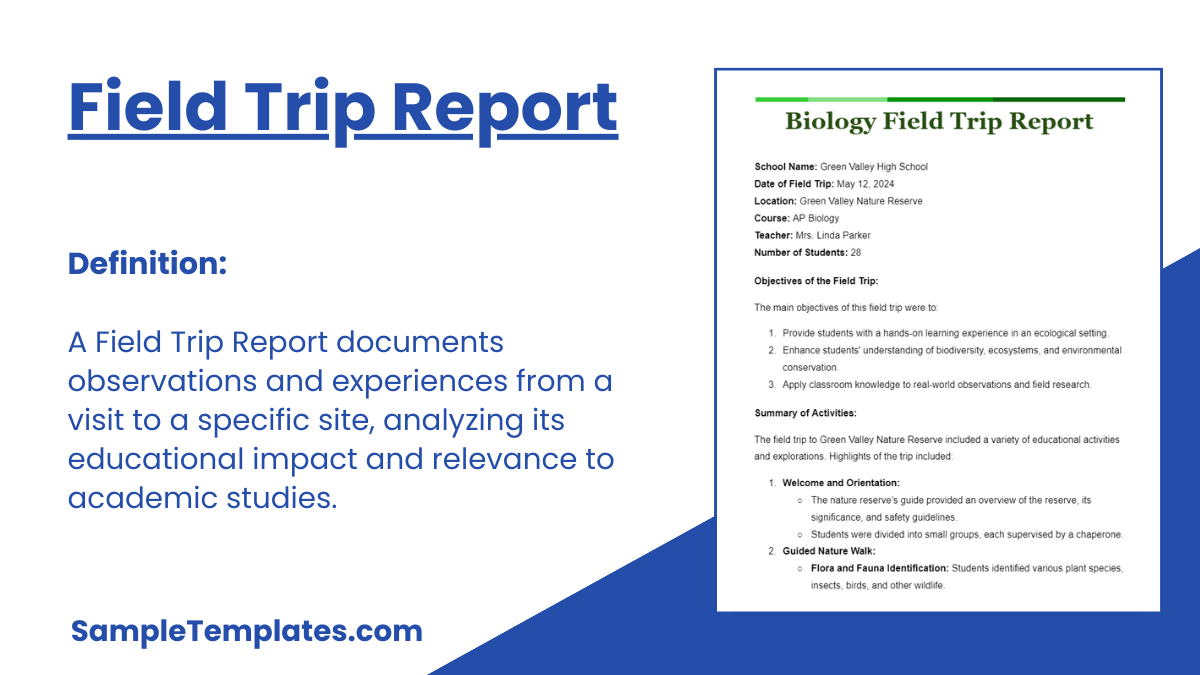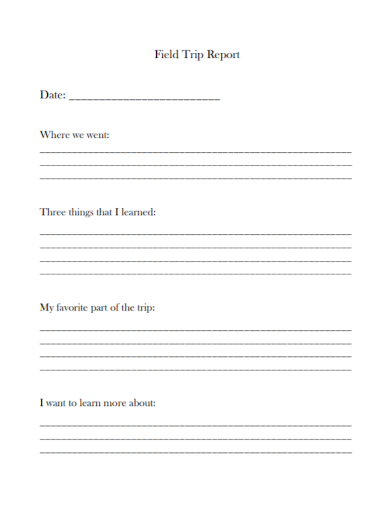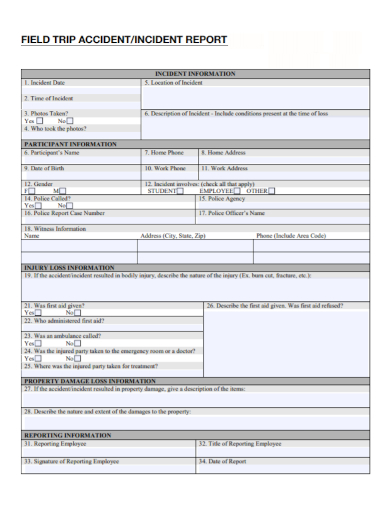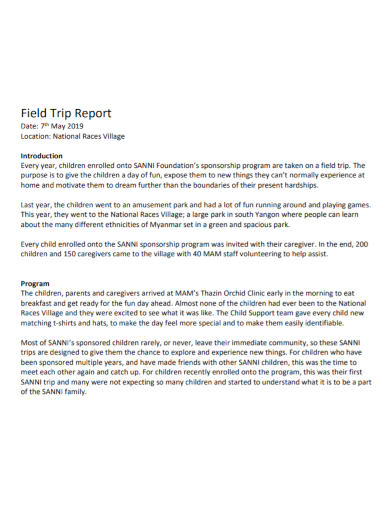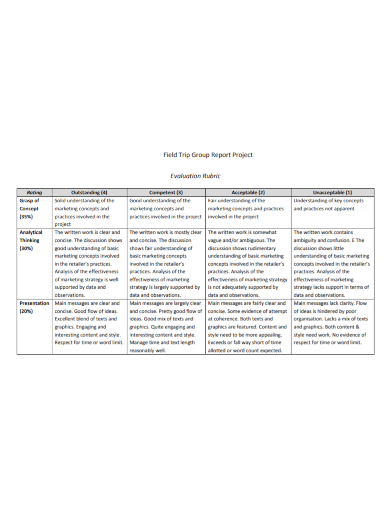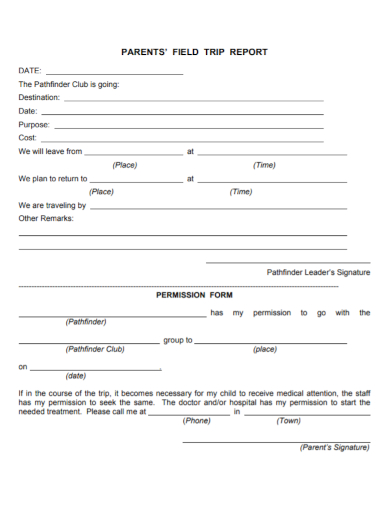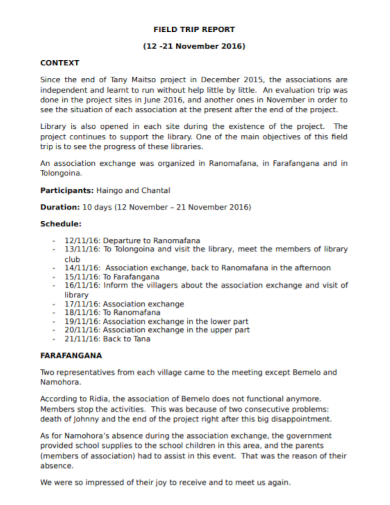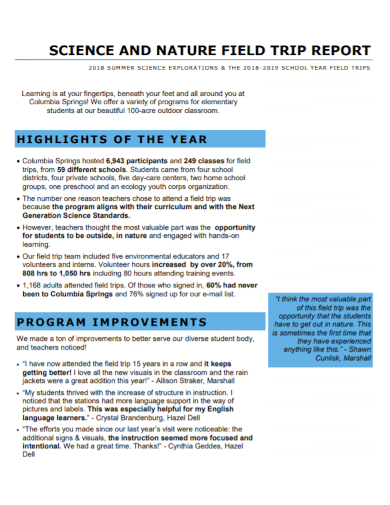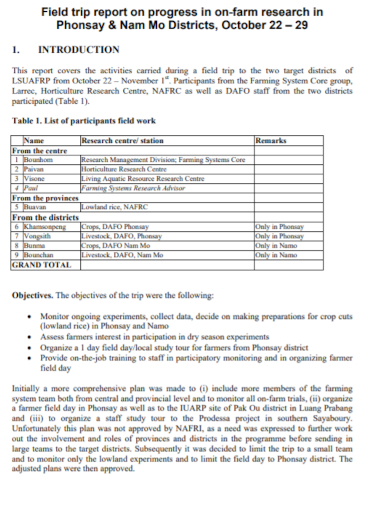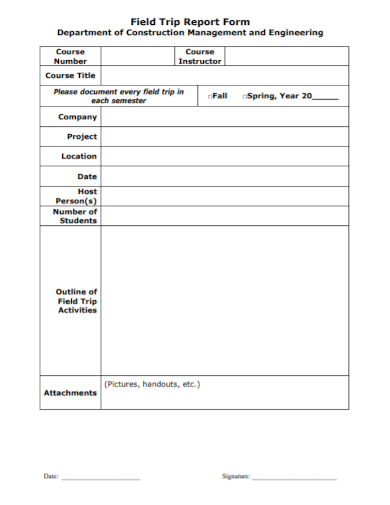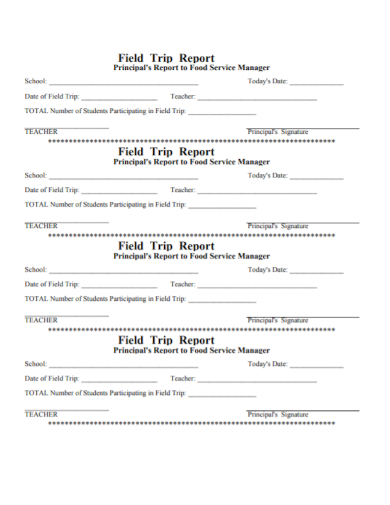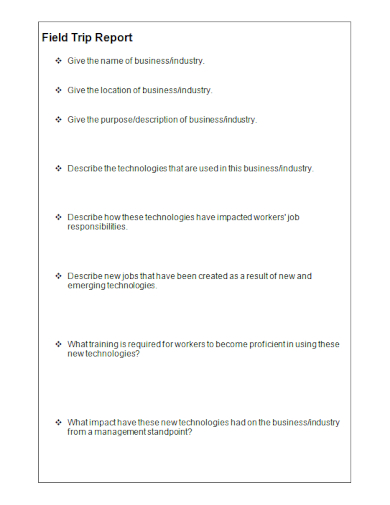Are you a student who recently went on an educational field trip? Or perhaps you are a professional researcher in agriculture who needs to conduct an observation and analysis of a particular farm? If you consider engaging in field research paper, and supporting research in difficult environments, you need to have the right skills and expertise in managing effective and safer research statement. Working on different types of field reports can be nerve-racking and challenging for most of the students or new researchers. Don’t fret because in this article, we have some downloadable field trip report samples to guide you. Keep on reading!
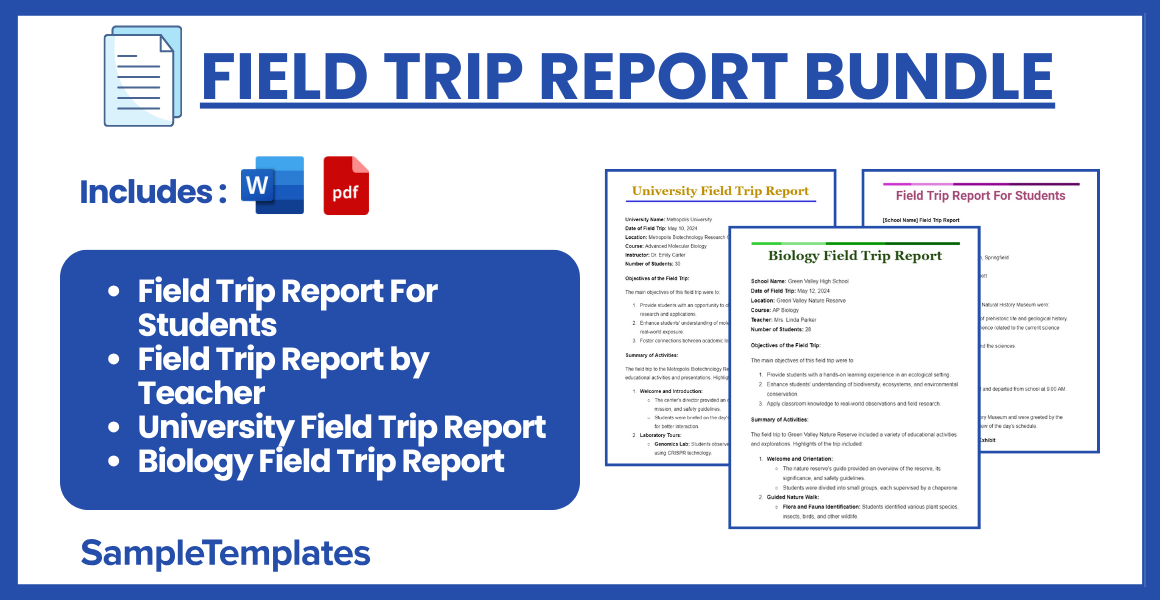
Download Field Trip Report Bundle
Field Trip Report For Students
[School Name] Field Trip Report
Trip Details:
- Date: May 24, 2024
- Destination: Natural History Museum, Springfield
- Grade Level: 5th Grade
- Teacher in Charge: Mrs. Laura Bennett
Objectives of the Trip
The primary objectives of the field trip to the Natural History Museum were:
- To enhance students’ understanding of prehistoric life and geological history.
- To provide a hands-on learning experience related to the current science curriculum.
- To inspire interest in natural history and the sciences.
Summary of Activities
9:00 AM – Departure from School:
- Students boarded the bus at 8:45 AM and departed from school at 9:00 AM.
10:00 AM – Arrival at Museum:
- The group arrived at the Natural History Museum and were greeted by the museum staff who provided an overview of the day’s schedule.
10:15 AM – Guided Tour of the Dinosaur Exhibit:
- A museum guide led the students through the dinosaur exhibit, highlighting various species, their habitats, and the periods in which they lived.
11:30 AM – Interactive Workshop on Fossils:
- Students participated in a workshop where they learned about fossil formation and were able to handle real fossils.
12:30 PM – Lunch Break:
- Students had lunch in the museum’s designated picnic area.
1:15 PM – Exploration of the Earth Science Wing:
- The group explored exhibits on geology, including rock formations, minerals, and the Earth’s layers.
2:00 PM – Educational Film:
- Students watched an educational film on the evolution of life on Earth in the museum’s theater.
2:45 PM – Free Exploration and Souvenir Shop:
- Students had the opportunity to explore other exhibits of interest and visit the souvenir shop.
3:30 PM – Departure from Museum:
- The group boarded the bus and left the museum at 3:30 PM.
4:30 PM – Arrival at School:
- Students returned to school at 4:30 PM.
Learning Outcomes
The field trip successfully met its objectives, as evidenced by:
- Increased Engagement: Students showed high levels of interest and engagement during the museum tour and activities.
- Enhanced Understanding: The hands-on experiences and interactive workshops helped reinforce the science concepts being studied in class.
- Positive Feedback: Both students and chaperones provided positive feedback about the trip, highlighting the dinosaur exhibit and fossil workshop as the most enjoyable parts.
Recommendations for Future Trips
- Extended Time: Allow more time for free exploration as students were particularly enthusiastic about the interactive exhibits.
- Pre-Trip Preparation: Provide students with background information and pre-visit activities to enhance their learning experience.
- Follow-Up Activities: Incorporate follow-up activities in the classroom to reinforce what was learned during the trip.
Acknowledgments
Special thanks to the parent volunteers and museum staff for their support and assistance in making this field trip a success.
Report Prepared By: Mrs. Laura Bennett
5th Grade Teacher
[School Name]
May 24, 2024
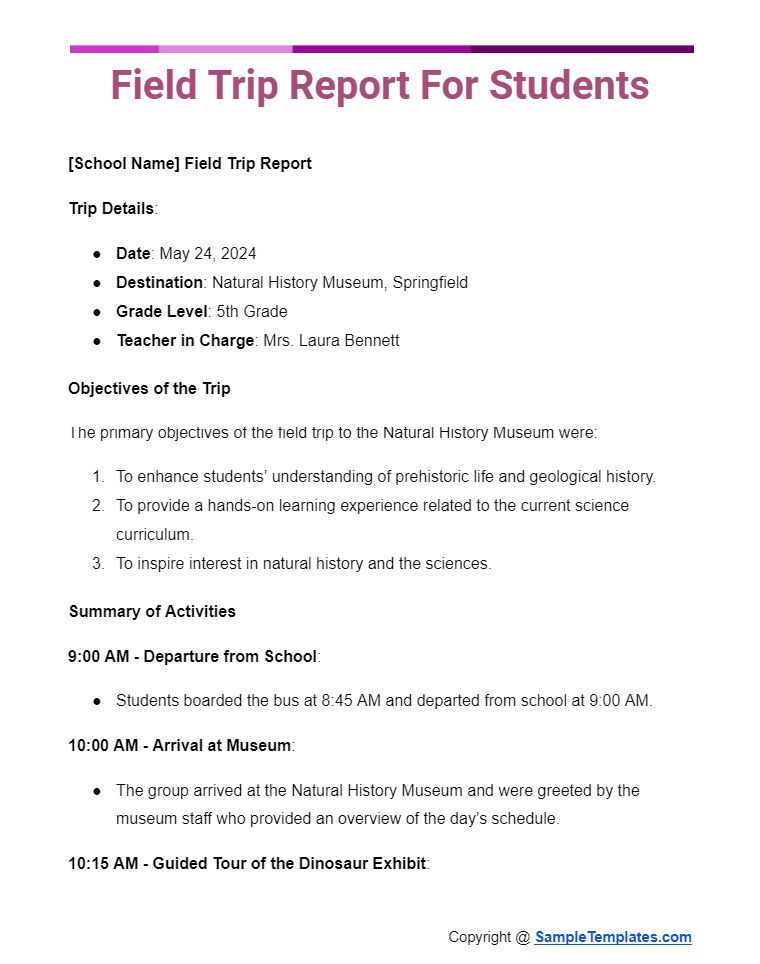
Field Trip Report by Teacher
School Name: Springfield High School
Date of Field Trip: May 15, 2024
Location: Springfield Science Museum
Teacher: Ms. Sarah Thompson
Grade: 9th Grade
Number of Students: 25
Objectives of the Field Trip:
The main objectives of this field trip were to:
- Enhance students’ understanding of scientific concepts through real-world exhibits.
- Provide hands-on learning experiences that complement classroom instruction.
- Foster students’ curiosity and interest in science.
Summary of Activities:
The field trip to the Springfield Science Museum included a variety of educational activities and exhibits. Highlights of the trip included:
- Introduction and Orientation:
- The museum staff provided an overview of the exhibits and safety guidelines.
- Students were divided into small groups, each supervised by a chaperone.
- Guided Tour of the Exhibits:
- Dinosaur Exhibit: Students learned about different dinosaur species, fossils, and paleontology.
- Planetarium Show: A 30-minute show about the solar system, stars, and galaxies.
- Interactive Science Lab: Students participated in hands-on experiments related to physics and chemistry.
- Special Workshop:
- Robotics Workshop: Students built and programmed simple robots, reinforcing concepts from their technology and engineering classes.
- Lunch Break:
- Students enjoyed a picnic lunch in the museum’s outdoor garden area.
- Self-Guided Exploration:
- Students had the opportunity to explore other exhibits of interest, such as the human body, energy conservation, and environmental science.
Learning Outcomes:
The field trip successfully met its objectives. Key learning outcomes included:
- Enhanced understanding of scientific principles through direct observation and interaction with exhibits.
- Increased student engagement and interest in science subjects.
- Improved teamwork and collaboration skills through group activities and discussions.
Student Feedback:
Students provided positive feedback about the field trip, particularly enjoying the interactive science lab and the robotics workshop. They expressed excitement about the real-world applications of their classroom learning.
Recommendations:
- Future Field Trips: Consider scheduling additional field trips to other educational venues, such as a natural history museum or a planetarium.
- Pre-Trip Preparation: Provide students with more background information and pre-trip assignments to enhance their learning experience.
- Post-Trip Activities: Implement follow-up activities in the classroom to reinforce the concepts learned during the field trip.
Conclusion:
The field trip to the Springfield Science Museum was a valuable educational experience for the 9th-grade students. It successfully achieved its objectives of enhancing scientific understanding and fostering a love for learning. Future trips of this nature are highly recommended to continue providing students with enriching educational opportunities.
Submitted by:
Ms. Sarah Thompson
9th Grade Science Teacher
Springfield High School
Date: May 20, 2024
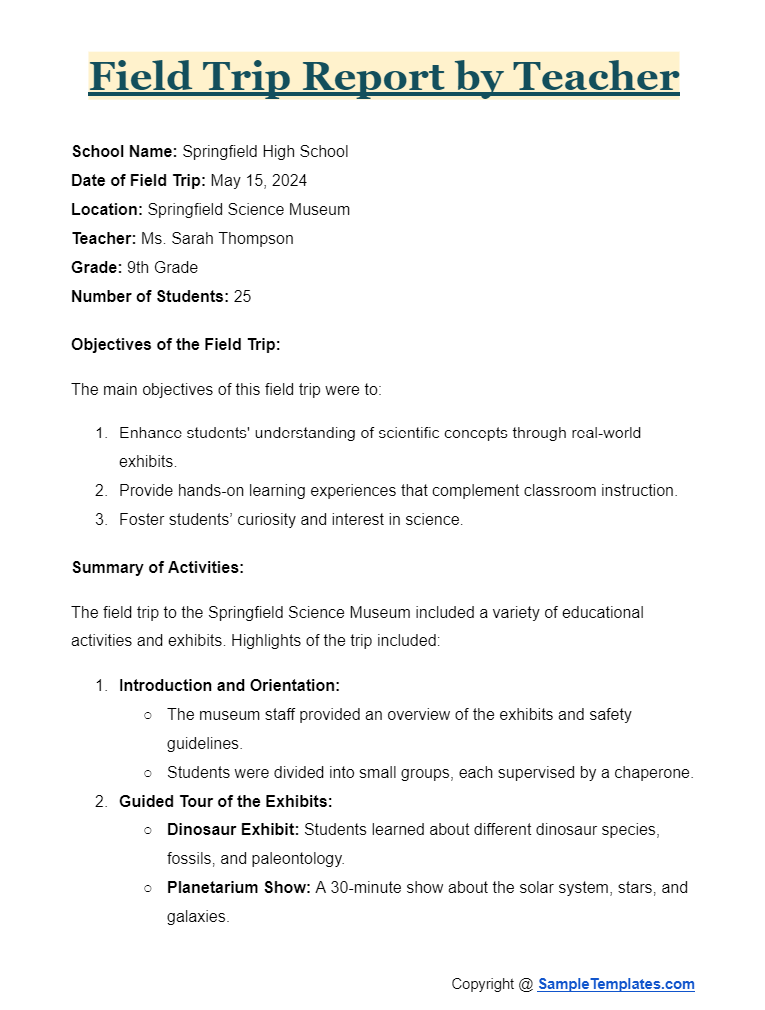
University Field Trip Report
University Name: Metropolis University
Date of Field Trip: May 10, 2024
Location: Metropolis Biotechnology Research Center
Course: Advanced Molecular Biology
Instructor: Dr. Emily Carter
Number of Students: 30
Objectives of the Field Trip:
The main objectives of this field trip were to:
- Provide students with an opportunity to observe cutting-edge biotechnology research and applications.
- Enhance students’ understanding of molecular biology concepts through real-world exposure.
- Foster connections between academic learning and industry practices.
Summary of Activities:
The field trip to the Metropolis Biotechnology Research Center included a variety of educational activities and presentations. Highlights of the trip included:
- Welcome and Introduction:
- The center’s director provided an overview of the research facility, its mission, and safety guidelines.
- Students were briefed on the day’s schedule and divided into small groups for better interaction.
- Laboratory Tours:
- Genomics Lab: Students observed ongoing research on gene editing using CRISPR technology.
- Protein Engineering Lab: Demonstrations on the design and production of therapeutic proteins.
- Bioinformatics Suite: Insight into how computational tools are used to analyze biological data.
- Research Presentations:
- Cancer Research: Presentation on the latest advancements in cancer immunotherapy.
- Environmental Biotechnology: Discussion on bioremediation techniques for environmental cleanup.
- Agricultural Biotechnology: Overview of genetically modified crops and their benefits.
- Interactive Workshop:
- Hands-On Experiment: Students participated in a DNA extraction experiment, providing practical experience in a laboratory setting.
- Networking Lunch:
- Students had lunch with researchers and staff, providing an opportunity to discuss career paths and industry trends.
- Q&A Session:
- An open forum where students could ask questions and engage in discussions with leading scientists and researchers.
Learning Outcomes:
The field trip successfully met its objectives. Key learning outcomes included:
- Enhanced understanding of molecular biology and biotechnology through direct observation and interaction with experts.
- Increased student engagement and interest in pursuing careers in biotechnology and related fields.
- Improved practical skills through hands-on laboratory experience.
Student Feedback:
Students provided overwhelmingly positive feedback about the field trip. They particularly appreciated the hands-on experiment and the opportunity to interact with researchers. Many students expressed a deeper interest in biotechnology and a desire to explore research opportunities.
Recommendations:
- Future Field Trips: Organize additional field trips to other research institutions and biotech companies to broaden students’ exposure to the field.
- Pre-Trip Preparation: Assign pre-trip readings and discussions to ensure students have a solid understanding of the concepts they will observe.
- Post-Trip Activities: Conduct follow-up activities, such as lab reports or presentations, to reinforce the learning experience.
Conclusion:
The field trip to the Metropolis Biotechnology Research Center was an invaluable educational experience for the Advanced Molecular Biology students. It successfully achieved its objectives of enhancing scientific understanding and fostering a connection between academic learning and industry practices. Future trips of this nature are highly recommended to continue providing students with enriching educational opportunities.
Submitted by:
Dr. Emily Carter
Professor of Molecular Biology
Metropolis University
Date: May 20, 2024
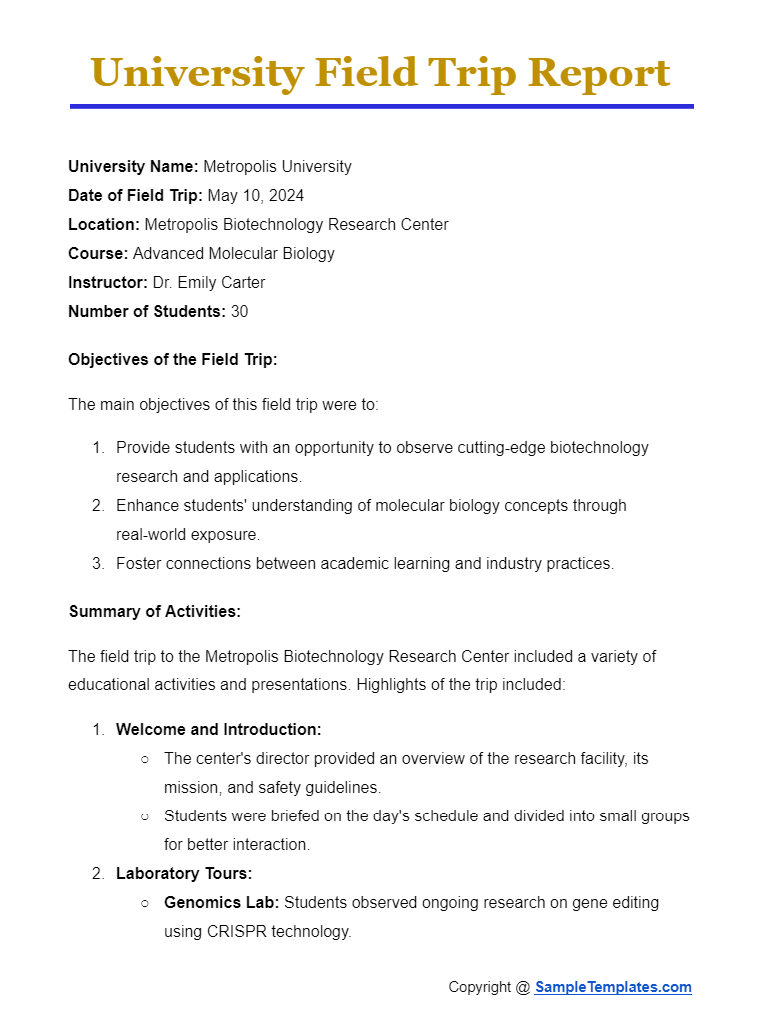
Biology Field Trip Report
School Name: Green Valley High School
Date of Field Trip: May 12, 2024
Location: Green Valley Nature Reserve
Course: AP Biology
Teacher: Mrs. Linda Parker
Number of Students: 28
Objectives of the Field Trip:
The main objectives of this field trip were to:
- Provide students with a hands-on learning experience in an ecological setting.
- Enhance students’ understanding of biodiversity, ecosystems, and environmental conservation.
- Apply classroom knowledge to real-world observations and field research.
Summary of Activities:
The field trip to Green Valley Nature Reserve included a variety of educational activities and explorations. Highlights of the trip included:
- Welcome and Orientation:
- The nature reserve’s guide provided an overview of the reserve, its significance, and safety guidelines.
- Students were divided into small groups, each supervised by a chaperone.
- Guided Nature Walk:
- Flora and Fauna Identification: Students identified various plant species, insects, birds, and other wildlife.
- Habitat Exploration: Examination of different habitats within the reserve, including wetlands, forests, and grasslands.
- Ecosystem Study:
- Water Quality Testing: Students conducted tests on water samples from the reserve’s pond to measure pH, turbidity, and dissolved oxygen levels.
- Soil Sampling: Collection and analysis of soil samples to study composition and microorganism presence.
- Biodiversity Assessment:
- Transect and Quadrat Sampling: Techniques used to estimate species diversity and abundance in different areas of the reserve.
- Species Observation: Recording and analyzing the behavior and interactions of various species.
- Conservation Workshop:
- Discussion on Conservation Practices: Presentation by the reserve staff on the importance of conservation and the efforts being made to protect local ecosystems.
- Interactive Session: Students participated in a discussion on how they can contribute to conservation efforts.
- Lunch Break:
- Students enjoyed a picnic lunch in a designated area of the reserve.
- Reflection and Q&A Session:
- Students shared their observations and findings, followed by a Q&A session with the reserve’s guide and biology teacher.
Learning Outcomes:
The field trip successfully met its objectives. Key learning outcomes included:
- Enhanced understanding of biodiversity and ecosystem dynamics through direct observation and hands-on activities.
- Increased student engagement and interest in environmental science and conservation.
- Improved practical skills in field research techniques and data analysis.
Student Feedback:
Students provided positive feedback about the field trip, particularly enjoying the hands-on activities and the opportunity to observe wildlife in their natural habitat. They expressed a greater appreciation for environmental conservation and a desire to participate in similar activities in the future.
Recommendations:
- Future Field Trips: Plan additional trips to other ecological sites and reserves to provide students with a diverse range of environmental experiences.
- Pre-Trip Preparation: Assign pre-trip readings and activities to ensure students are well-prepared and informed about the topics they will explore.
- Post-Trip Activities: Implement follow-up assignments, such as field reports or presentations, to reinforce the learning experience and encourage further research.
Conclusion:
The field trip to Green Valley Nature Reserve was an enriching educational experience for the AP Biology students. It successfully achieved its objectives of enhancing scientific understanding and fostering a connection between classroom learning and real-world ecology. Future trips of this nature are highly recommended to continue providing students with valuable educational opportunities.
Submitted by:
Mrs. Linda Parker
AP Biology Teacher
Green Valley High School
Date: May 18, 2024
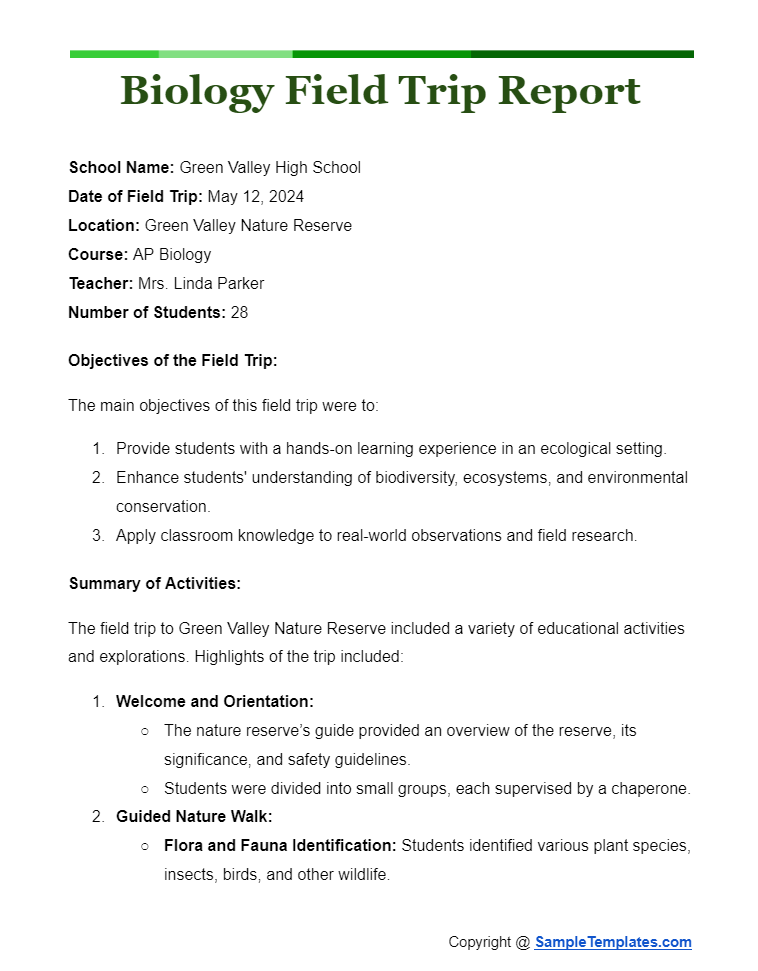
Browse More Templates On Field Trip Report
FREE 11+ Field Trip Report Samples
1. Sample Field Trip Report
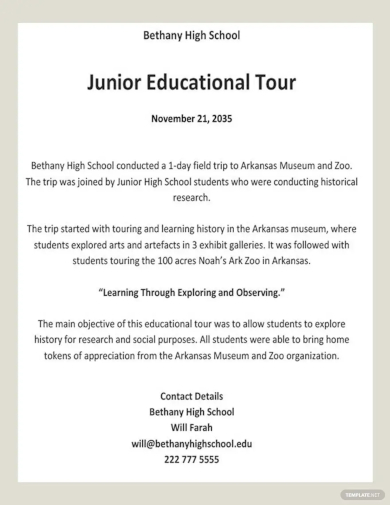
2. School Field Trip Report Sample PDF
Tips For Writing a Field Trip Report
Writing a field trip report outline involves documenting the activities, experiences, and learning outcomes of the trip. Here are some tips to help you craft a comprehensive and effective field trip report:
- Start with Basic Information:
- Include the name of the institution or school, the date of the field trip, the location visited, the course or subject related to the trip, the name of the teacher or instructor, and the number of students who participated.
- State the Objectives:
- Clearly outline the objectives of the field trip. What were the educational goals? What did you hope the students would learn or experience?
- Summarize the Activities:
- Provide a detailed summary of the activities that took place during the field trip. Describe the sequence of events, including any guided tours, workshops, experiments, or hands-on activities.
- Highlight Key Learning Outcomes:
- Discuss the main learning outcomes of the trip. What concepts or skills did the students learn or reinforce? How did the trip enhance their understanding of the subject matter?
- Include Student Feedback:
- If possible, include feedback from the students about their experiences. What did they enjoy the most? What did they find challenging or interesting?
- Make Recommendations:
- Offer recommendations for future field trips. What worked well and what could be improved? Suggest any additional activities or pre/post-trip assignments that could enhance the learning experience.
- Use a Professional Tone:
- Maintain a formal and professional tone throughout the sample report. Ensure that your writing is clear, concise, and free of grammatical errors.
- Add Visuals:
- If appropriate, include photographs, charts, or diagrams that illustrate the activities and experiences of the field trip. Visual aids can make the report more engaging and informative.
- Reflect on Personal Observations:
- Include your own observations as the teacher or instructor. How did the students engage with the material? Were there any unexpected outcomes or particularly noteworthy moments?
- Conclude Effectively:
- Summarize the overall success of the field trip in the conclusion. Reinforce the importance of such trips in achieving educational goals and fostering student engagement.
3. Field Trip Report
4. Field Trip Report Template
Main Parts of Report
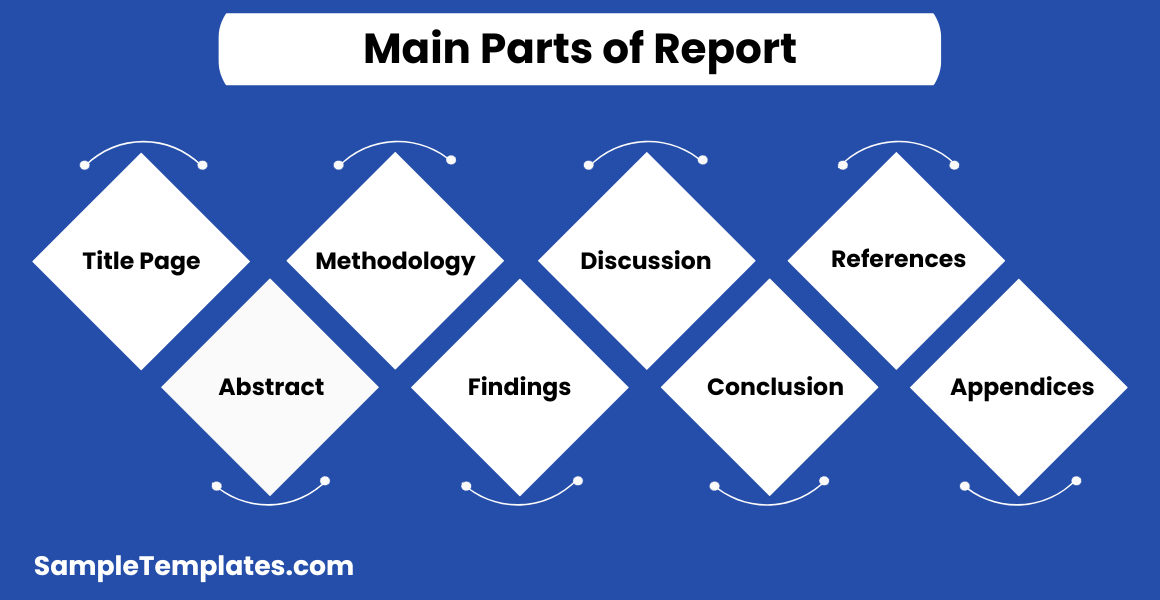
A report format generally comprises several main parts, each serving a distinct function to ensure the document is clear, informative, and well-organized. The main parts of a report are as follows:
- Title Page:
- Purpose: To provide essential information about the report.
- Content: Title of the report, author’s name, date, and any other relevant details such as the organization or institution.
- Table of Contents:
- Purpose: To list the main sections and subsections of the report writing with their page numbers.
- Content: An organized outline of the report’s structure for easy navigation.
- Abstract/Executive Summary:
- Purpose: To provide a brief summary of the report’s key points.
- Content: An overview of the objectives, methodology, findings, conclusions, and recommendations (if applicable), usually in a concise format.
- Introduction:
- Purpose: To introduce the report’s topic, purpose, and scope.
- Content: Background information, objectives of the report, and an outline of what the report will cover.
- Methodology:
- Purpose: To explain how the information was gathered or the research was conducted.
- Content: Detailed description of the methods, procedures, and tools used for data collection and analysis.
- Findings/Results:
- Purpose: To present the data or information collected during the research or investigation.
- Content: Detailed account of the findings, often supported by tables, charts, graphs, or other visual aids to illustrate key points.
- Discussion/Analysis:
- Purpose: To interpret and analyze the findings.
- Content: Explanation of the significance of the findings, discussion of any patterns or trends observed, and how the findings relate to the report’s objectives or hypotheses.
- Conclusion:
- Purpose: To summarize the main findings and their implications.
- Content: Recap of the key points, addressing the objectives of the report, and providing a clear statement of the overall conclusions drawn from the research.
- Recommendations (if applicable):
- Purpose: To suggest actions or further steps based on the findings.
- Content: Practical suggestions or recommendations for future research, policy changes, or other actions that should be taken.
- References/Bibliography:
- Purpose: To list all the sources of information cited in the report.
- Content: A detailed list of books, articles, websites, and other sources, formatted according to a standardized citation style.
- Appendices (if applicable):
- Purpose: To provide supplementary material that supports the main content.
- Content: Additional data, detailed tables, questionnaires, or other relevant documents referenced in the report but too lengthy to include in the main sections.
5. Student Field Visit Report Sample
6. Report Writing On Field Trip
7. Field Trip Report Sample PDF
8. Field Trip Report Format
9. Field Trip Report Example
10. Field Visit Report Writing Example
11. Educational Field Trip Report Sample
12. Field Visit Report Sample
Whether you are a graduate student who works with your academic advisors as you engage in field research or being one of the lead investigators of certain research projects, you need to be able to write a well-detailed and technical analysis field trip report. Additionally, you must use some diverse fieldwork methods such as ethnographic method, observational methods, comparative method, intersubjectivity, and other methods. To assist you in writing an informative field report, we provide you some downloadable and printable field trip report samples here in different formats. Simply click the field trip report templates in this article and start downloading now!
What is a Field Trip Report?
A field report is a clear and well-detailed report of a student or researcher while demonstrating primary activities, tasks, significant accomplishments, and other integral aspects of a field visit report in a certain place or event through writing.
How to Write a Field Trip Report
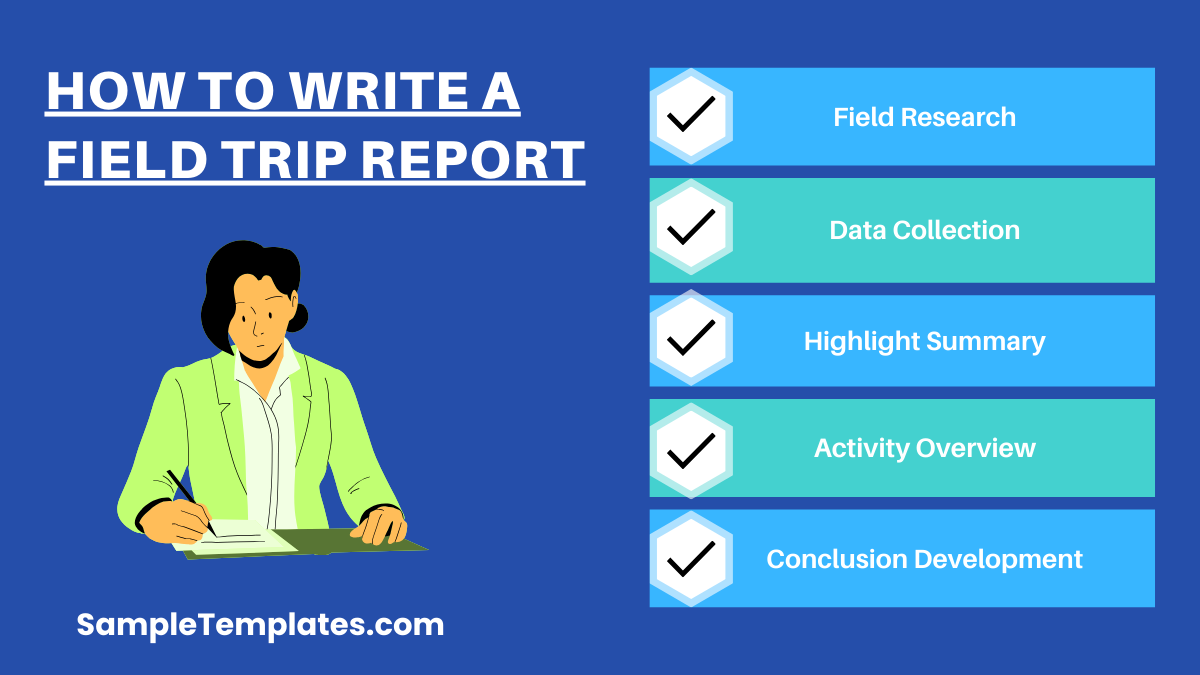
Writing a clear and cohesive field report is essential to maintain the essence and content of the field trip. Thus, when you work on your field trip report, it must have good characteristics such as simplicity, consistency, precision and accuracy, topic relevance and many more. In order to guide you in preparing your narrative report of a field trip, we provide some useful tips that you should consider:
1. Conduct field research
First, you must conduct field research in the place or event that you are visiting. Your objectives should be measurable, actionable results that will support your field report writing. Ask some questions to the people around the area. Some examples of field research are deciphering social metrics in a particular place, understanding the effects of food on child’s growth, etc.
2. Collect fundamental data
Being cognizant on the specific figures can help you in completing the field report thoroughly. Know about the opinions, insights, and other quantitative data analysis which appear to be highly fundamental to your report. Collecting and preserving these figures in your field report will assist you and other researchers in understanding relevant themes of a research study plan.
3. Summarize the highlighted points of the field trip
After that, you need to summarize the highlighted points of the field trip. It should be less than one page and easy for readers to skim. Use subheaders, short sentences, and bullet points to emphasize your main idea accurately. Include facts such as primary research objectives, sample timeline, and many others
4. Provide a simple overview of field trip activities
Provide a simple overview of field activities such as lectures, tours, sample worksheets, videos, and demonstrations. List down each of the activities and tasks involved in the place that you are covering.
5. Develop a conclusion
Think deeply about the main purpose and benefits of visiting the area or place of your field research trip. Develop a conclusion of the entire field trip by presenting the useful elements of the field trip. Understand the key lessons you acquired from the field trip and explain how you have greatly benefited from them.
FAQs
The purpose of a field trip is to help the students to conduct careful observation and sample assessment of people, places, and/or events, as well as a comprehensive analysis of the observation details. In this way, the students can determine and organize prevalent topics according to the research problem of a certain study.What is the purpose of a field trip?
If you need to write a sample brief summary for a field trip, indicate a clear and concise title and demonstrate the major elements in your introduction. Then, provide comprehensive information of the facility that you visited. Add several examples about the activities and tasks that happened in the field trip. Discuss what are the things that surprised you and other findings you gathered during the field trip.How to write a brief summary for a field trip?
A field report sample is necessary for the student or researcher when it comes to combining theory and analysis acquired through the application of observation techniques and practices. On the other hand, a survey report is a written document which contains the details collected during the survey. What is the difference between a field report and a survey report?
How do you describe a field trip?
A field trip is an educational outing where students or participants visit a location outside their regular classroom setting to explore and learn about specific subjects or concepts hands-on.
What is an example of a field trip?
An example of a field trip is a visit to a natural history museum, where students can see and learn about fossils, dinosaurs, and various geological exhibits to enhance their understanding of Earth’s history.
In conclusion, this field trip report encapsulates the enriching experiences and educational insights gained during our excursion. The interactive learning opportunities provided a deeper understanding of [subject]. I extend gratitude to all participants, contributing to a memorable and valuable journey that enhances our collective knowledge and fosters a spirit of discovery.
Related Posts
FREE 16+ Sample Summary Reports
FREE 14+ Permission Slip Samples
FREE 14+ Sample Trip Itinerary
FREE 11+ Sample Fall Incident Reports
FREE 8+ Board Memo Templates
FREE 8+ Accomplishment Report Samples
FREE 43+ Report Examples
FREE 18+ Weekly Report Templates
FREE 16+ Summary Report Templates
FREE 10+ Retail Trade Report Samples
FREE 9+ Road Trip Itinerary Samples
FREE 9+ Stock Audit Report Samples
FREE 9+ Sample Travel Log
FREE 8+ Sample Parent Release Forms
FREE 25+ Sample Trip Reports
